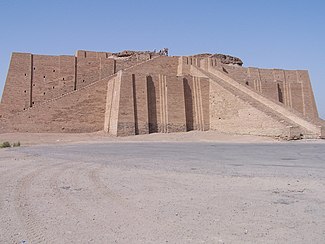| Revision as of 05:24, 4 August 2009 editClosedmouth (talk | contribs)148,166 editsm Protected Ziggurat of Ur: Move warring ( (indefinite))← Previous edit | Revision as of 08:13, 4 August 2009 edit undoDoug Weller (talk | contribs)Edit filter managers, Autopatrolled, Oversighters, Administrators264,298 edits "the great ziggurat of UR" is quite different from "the Great Ziggurat of UR", removing the references that only use 'great' as an adjectiveNext edit → | ||
| Line 1: | Line 1: | ||
| ] of ], near ], ]]] | ] of ], near ], ]]] | ||
| The '''Ziggurat of Ur''' (also known as the "Great Ziggurat of Ur") |
The '''Ziggurat of Ur''' (also known as the "Great Ziggurat of Ur")Ur</ref><ref>http://abcnews.go.com/International/wireStory?id=7575179 Great Ziggurat of Ur</ref> (] (]): '''Etemennigur''', meaning "House whose foundation creates terror"<ref name="mesopotamia.co.uk">,The Ziggurat of Ur, The British Museum</ref>) is an ancient ] ] in ], ]. The ziggurat was built by the ] ] and his son ] in approximately the ] during the ],<ref name="mesopotamia.co.uk"></ref> in dedication to the ] ]. The massive ] measures 210 feet (64m) in length, 150 feet (46m) in width and over 100 feet (30m) in height. | ||
| The ziggurat was a piece in a temple complex that served as an administrative center for the city, and which was thought to be the dwelling of the moon god Nanna, the patron deity of ], on earth. It is said that ziggurat serves as a tool to bridge the distance between the sky and the earth. The gods were believed to descend and visit the temple where only a selected group of priests and government officials may enter.<ref>Gardner's ''Art Through the Ages'' by Helen Gardner, Fred S. Kleiner, Christin J. Mamiya</ref> | The ziggurat was a piece in a temple complex that served as an administrative center for the city, and which was thought to be the dwelling of the moon god Nanna, the patron deity of ], on earth. It is said that ziggurat serves as a tool to bridge the distance between the sky and the earth. The gods were believed to descend and visit the temple where only a selected group of priests and government officials may enter.<ref>Gardner's ''Art Through the Ages'' by Helen Gardner, Fred S. Kleiner, Christin J. Mamiya</ref> | ||
Revision as of 08:13, 4 August 2009

The Ziggurat of Ur (also known as the "Great Ziggurat of Ur")Ur</ref> (Sumerian (transliterated): Etemennigur, meaning "House whose foundation creates terror") is an ancient Sumerian ziggurat in Dhi Qar Province, Iraq. The ziggurat was built by the Sumerian King Ur-Nammu and his son Shulgi in approximately the 21st century BC during the Third Dynasty of Ur, in dedication to the moon god Nanna. The massive step pyramid measures 210 feet (64m) in length, 150 feet (46m) in width and over 100 feet (30m) in height.
The ziggurat was a piece in a temple complex that served as an administrative center for the city, and which was thought to be the dwelling of the moon god Nanna, the patron deity of Ur, on earth. It is said that ziggurat serves as a tool to bridge the distance between the sky and the earth. The gods were believed to descend and visit the temple where only a selected group of priests and government officials may enter.
The construction of the ziggurat was finished in the 21st century BC by King Shulgi, who, in order to win the allegiance of cities, proclaimed himself a god. During his 48-year reign, the city of Ur grew to be the capital of a state controlling much of Mesopotamia. Later though, the fortunes of Ur declined, and it was sacked by the Elamites in 2004 BC.
King Nabonidus, the last king of the Neo-Babylonian Empire in the 6th century BC, after "finding little left but the last stage and nothing to guide him as to the monument's original appearance", had it restored in seven stages rather than three. Today, after more than 4000 years, the ziggurat is still well preserved in large parts, and partially reconstructed. It is the only major remainder of Ur in southern Iraq.
See also
References
- http://abcnews.go.com/International/wireStory?id=7575179 Great Ziggurat of Ur
- ^ Explore the ziggurat of Ur,The Ziggurat of Ur, The British Museum
- Gardner's Art Through the Ages by Helen Gardner, Fred S. Kleiner, Christin J. Mamiya
- Sumeria, the "Civilized Land"
- Trudy Ring, Robert M. Salkin, Sharon La Boda. International Dictionary of Historic Places. ISBN 1884964036. Page 719.
External links
- Template:Geolinks-US-streetscale
- A brief history of the Sumerian Ziggurat at Ur
- Archaeology of ancient Iraq with a section on the ziggurat
- The Harran and Ur Latitudes, and Tell Göbekli Tepe
This Iraq-related article is a stub. You can help Misplaced Pages by expanding it. |